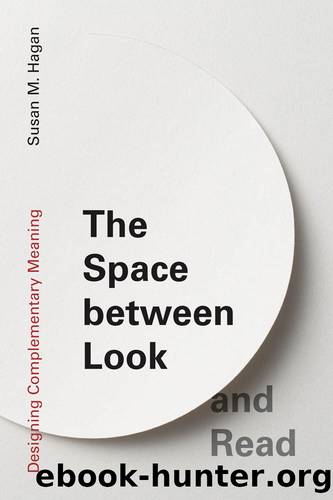The Space between Look and Read by Susan M. Hagan

Author:Susan M. Hagan
Language: eng
Format: epub
Tags: Communication Design; Complementary Meaning; Cross-modal; Design; Framework; Image; Interaction Design; Inter-play; Motion Design; Multimodal; Multimodality; Ties; Time-motion; Typography; Visual Rhetoric;
Publisher: MIT Press
When explicit-trails appear in longer passages of text, they can replace parentheticals such as â(See figure 10),â which does not offer a strong invitation to move from sequential to spatial processing because a parenthetical is not a strong command. Asking an audience to move from their practice of discerning intent in the text to the expectation to search for image information flies in the face of the ârule of simplicityâ (Arnheim, 1974; Goldstein, 2001, 2002). We like to do the simplest thing. Moving from the structure of sequential processing to idiosyncratic looking is not just a different sequence; itâs a different system. That move is especially taxing when there is no easy way to get back to what you were reading when figure 10 cunningly invited you to look away. An explicit-trail makes the journey easier.
Explicit-trails usually pair with other Grouping Ties that act more globally. Shared-location and juxtaposed-location hold the larger-grained elements together, while explicit-trails can reinforce the smaller relationships. Unfortunately, books where looking is more critical, like biology and art history and the one youâre reading now, still maintain a â(See Figure 10)â wayfinding system.
Explicit-trails also form when bolded words invite the move from text to an image as would be the case if a command boldly stated look at the âcheeseâ now. Then the cheese becomes easier to consider, knowing the bolded text is there to help you back. The bolded words marked a point between reading and looking that is easier to navigate. It suggests that when the audience finishes looking, a structure is in place so that they can find the way back again.
Download
This site does not store any files on its server. We only index and link to content provided by other sites. Please contact the content providers to delete copyright contents if any and email us, we'll remove relevant links or contents immediately.
POP by Steven Heller(3327)
Japanese Design by Patricia J. Graham(3139)
The Power of Broke by Daymond John(2936)
Architecture 101 by Nicole Bridge(2782)
Indistractable: How to Control Your Attention and Choose Your Life by Nir Eyal(2360)
Fusion 360 for Makers by Lydia Sloan Cline(2336)
Batik by Rudolf Smend(2155)
Actionable Gamification: Beyond Points, Badges, and Leaderboards by Yu-kai Chou(2141)
Origami Art by Michael G. Lafosse & Richard L. Alexander(2081)
Homebody by Joanna Gaines(2049)
Whiskey in a Teacup by Reese Witherspoon(1957)
Worn in New York by Emily Spivack(1946)
Feng Shui by Stephen Skinner(1918)
Austin Kleon by Steal Like an Artist(1907)
Simple Gatherings by Melissa Michaels(1884)
Don't Make Me Think, Revisited: A Common Sense Approach to Web Usability by Steve Krug(1842)
Ryan Korban by Ryan Korban(1736)
Hygge: The Danish Art of Happiness by Marie Tourell Søderberg(1711)
The Joy of Hygge by Jonny Jackson(1706)
